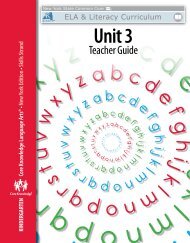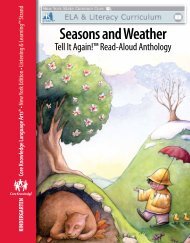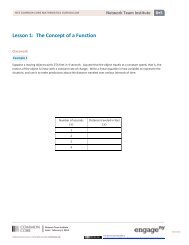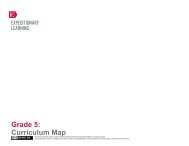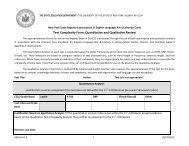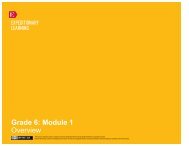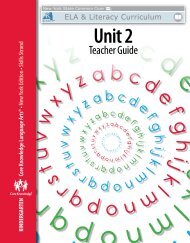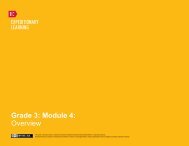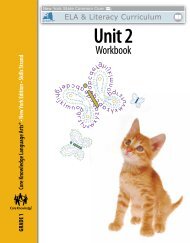Skills Unit 2 Teacher Guide - EngageNY
Skills Unit 2 Teacher Guide - EngageNY
Skills Unit 2 Teacher Guide - EngageNY
You also want an ePaper? Increase the reach of your titles
YUMPU automatically turns print PDFs into web optimized ePapers that Google loves.
silent ‘e’. Or you may have used the phrase magic ‘e’. Of these two phrases,<br />
we very much prefer magic ‘e’. There are a few issues in telling students<br />
some letters are silent. In truth, all letters are silent. (If they could speak,<br />
we would not have to read them and turn them back into sounds.) Also the<br />
phrase silent letter may lead some students to believe that only some letters<br />
in a word matter as far as determining the pronunciation of the word whereas<br />
others have no purpose. In fact, the ‘e’ in kite is every bit as important in<br />
terms of determining pronunciation as the ‘i’. Without the ‘e’, the word would<br />
be pronounced kit.<br />
All in all, the notion of a magic ‘e’ better reflects the role of ‘e’ in these<br />
spellings. We therefore encourage you to avoid teaching the concept of silent<br />
‘e’, or other silent letters, in general. For example, in the word light, it is more<br />
useful to think of ‘igh’ as a three-letter spelling (a trigraph) for /ie/ than it is<br />
to think of ‘i’ as standing for /ie/ and ‘gh’ as being “silent.” If you think of all<br />
of the letters in a word as being part of a spelling, then there is no need to<br />
introduce the concept of “silent” letters.<br />
For the same reason, we strongly discourage you from using the popular<br />
phonics jingle “when two vowels go walking, the first one does the talking.”<br />
Statistical analyses indicate this rule is only correct about 50% of the time.<br />
Moreover, it misleads students into thinking vowels are letters, whereas<br />
in fact vowels are sounds. Finally, it suggests students only need to pay<br />
attention to the first letter in a vowel digraph. That is very bad advice. To be<br />
effective readers, students need to look at both letters in a digraph spelling.<br />
They need to pay attention to the ‘a’ and the ‘w’ in law, the ‘o’ and the ‘i’ in<br />
oil, and the ‘a’ and the ‘e’ in name.<br />
Similar Sounds: /ue/, /oo/, /oo/, and /u/<br />
There is a lot of potential for confusion regarding the four vowel sounds /ue/,<br />
/oo/, /oo/, and /u/.<br />
• The /ue/ sound as in cute is similar to the /oo/ sound as in boot. In fact,<br />
/ue/ actually contains the /oo/ sound. /ue/ is really a sound combination;<br />
it can be described as /y/ + /oo/.<br />
• The sound /oo/ as in soon is also somewhat similar to /oo/ as in look,<br />
and the confusion between these sounds is magnified by the fact that<br />
they share a single basic-code spelling.<br />
• The sound /oo/ as in look can also be confused with /u/ as in luck.<br />
10 <strong>Unit</strong> 2 | Introduction<br />
© 2013 Core Knowledge Foundation



